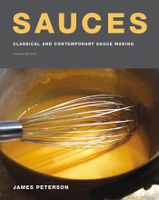Advertisement
Tips for the Restaurant Chef
Appears in
Published 1991
Brown sauces were originally designed to streamline the organization of professional kitchens. A modern kitchen, where stocks and glazes are made as part of the daily routine, will always have on hand the necessary bases for preparing classic and improvised sauces. Because the sauce bases are prepared in advance, cooks are freed from last-minute preparations and reductions and can put together complicated, time-consuming sauces in a matter of minutes.
The advantages of having standard sauce bases on hand in the professional kitchen are obvious. Unfortunately, the long-simmered stocks and glazes of the classic French kitchen can sometimes detract from the character and individuality of different types of dishes. It is perhaps for this reason that home-cooked meals are often satisfying in a way that restaurant meals are not. Consequently, many contemporary chefs have at least partially abandoned many of the traditional techniques used in classic sauce making and kitchen organization and are instead preparing integral sauces to order, keeping little in reserve beyond some freshly made stocks.

